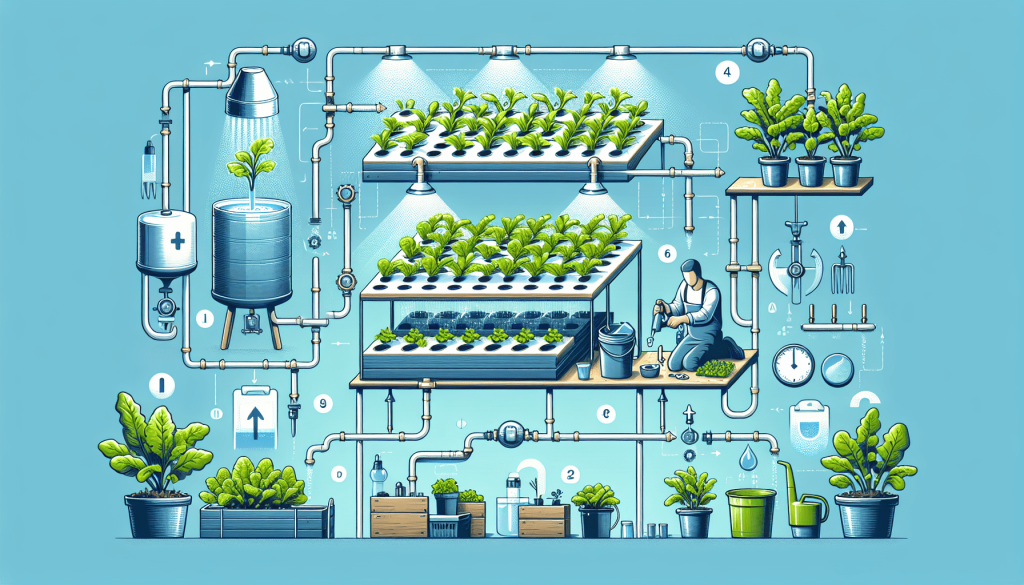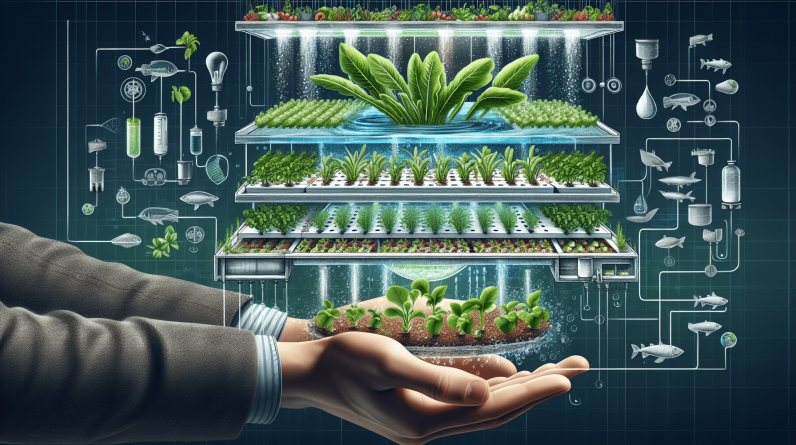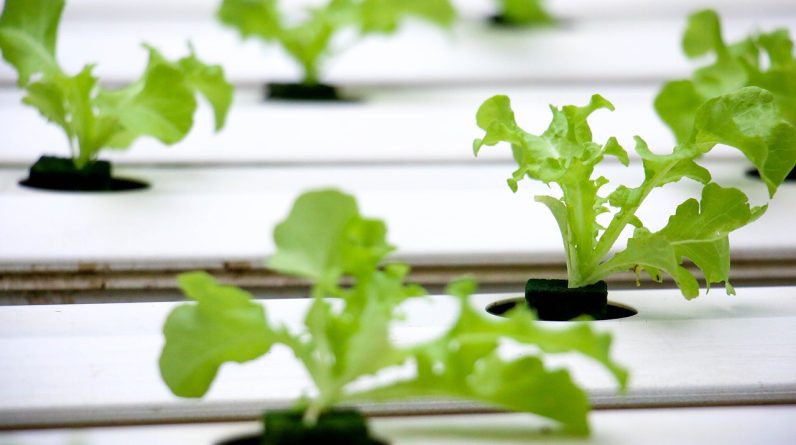
Imagine being able to grow your own fresh fruits, vegetables, and herbs right in the comfort of your own home, without the need for soil or traditional gardening methods. With a DIY hydroponic gardening system, this is now possible. Hydroponic gardening is a method of growing plants in nutrient-rich water instead of soil, allowing plants to absorb nutrients more efficiently and grow faster. In this article, we will explore the benefits of hydroponic gardening and provide step-by-step instructions on how you can create your very own DIY hydroponic gardening system. Get ready to unleash your green thumb and revolutionize your gardening experience!
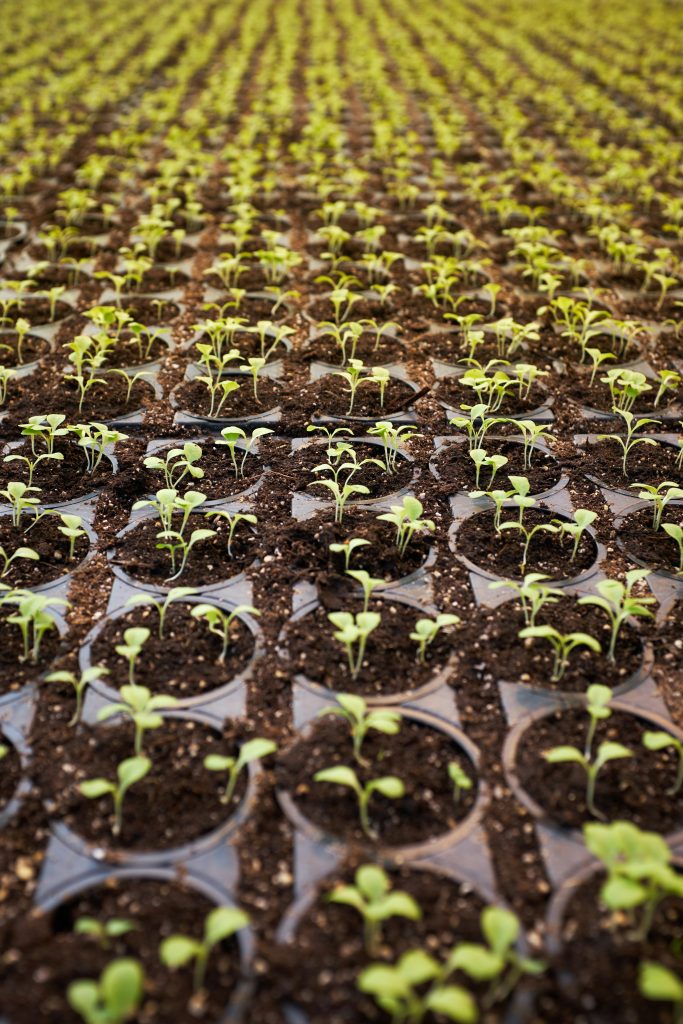
Choosing a Suitable Location
When it comes to setting up your DIY hydroponic system, the first thing to consider is the location. You have two main options: indoor or outdoor. Each has its own advantages and considerations, so let’s explore both.
Indoor vs. Outdoor
Indoor hydroponic systems are popular among urban gardeners and those who don’t have access to outdoor space. With an indoor setup, you have complete control over the environment, making it easier to maintain stable growing conditions. You can grow your plants year-round, regardless of the weather outside.
On the other hand, outdoor hydroponics can be a great option if you have ample outdoor space and want to take advantage of natural sunlight. Outdoor systems can accommodate larger plants or crops that require more space to grow. Keep in mind, however, that you’ll need to consider the climate and the potential for pests or other outdoor factors that may impact your plants.
Sunlight Requirements
Whether you choose an indoor or outdoor hydroponic system, light is crucial for plant growth. Different plants have varying sunlight requirements, so make sure to choose the right location based on the needs of your plants.
If you’re setting up your system indoors, you’ll need to supplement natural light with artificial grow lights. LED grow lights are a popular option as they are energy-efficient and provide the right spectrum of light for plant growth. Measure the light intensity and duration required by your chosen plants, and set up your lighting system accordingly.
For outdoor systems, choose a location that receives sufficient sunlight throughout the day. Monitor the amount of shade and exposure your plants will get to ensure they receive the ideal amount of light for growth.
Temperature Considerations
Temperature is another important factor to consider when choosing the location for your hydroponic system. Most plants thrive in temperatures between 70-80°F (21-27°C). Ensure that your chosen location can maintain a stable temperature within this range.
Indoor systems are easier to control in terms of temperature. You can use fans, heaters, or air conditioning to maintain the optimal conditions for your plants. Outdoor systems may require added consideration, especially in regions with extreme temperatures. You may need to provide shade or insulation to protect your plants from excessive heat or cold.
By carefully considering the location, sunlight requirements, and temperature considerations, you can create the perfect environment for your DIY hydroponic system.
Selecting Hydroponic System Type
Once you have chosen the location, it’s time to select the type of hydroponic system that best suits your needs. There are several popular options to choose from, each with its own advantages and considerations.
Wick System
The wick system is one of the simplest and most beginner-friendly hydroponic systems. It consists of a growing container with a wick made of absorbent material that delivers the nutrient solution to the plants’ roots. This system is low-maintenance and does not require electricity or pumps. It is ideal for small-scale setups or for growing plants with low water and nutrient requirements.
Water Culture System
The water culture system, also known as the deep water culture system, involves suspending the plants’ roots in a nutrient-rich solution. An air pump and air stone provide oxygen to the root zone, promoting healthy plant growth. This system is easy to set up and great for growing leafy greens and herbs.
Nutrient Film Technique (NFT)
The nutrient film technique is a system where a thin film of nutrient-rich solution continuously flows over the roots of the plants, providing them with the necessary nutrients. This method requires a sloping trough or channel, which allows the nutrient solution to flow through and recirculate. NFT is ideal for growing plants with shallow root systems, such as lettuce or basil.
Drip System
The drip system is widely used in hydroponics and involves using a pump to deliver the nutrient solution to the roots through drip emitters. The excess solution drips back into a reservoir, where it can be recirculated. Drip systems are versatile and can be used for a wide range of plants, making them a popular choice for home hydroponic setups.
Ebb and Flow System
The ebb and flow system, also known as the flood and drain system, periodically floods the growing container with nutrient solution, which is then drained back into a reservoir. This cycle mimics natural irrigation patterns and provides oxygen to the roots. It is suitable for larger plants and vegetables, such as tomatoes or cucumbers.
Aeroponic System
Aeroponics is a high-tech hydroponic system that involves suspending the plants’ roots in a mist or fog of nutrient solution. This method provides excellent oxygenation to the roots and promotes rapid growth. However, it requires precise control of misting intervals and nutrient levels, making it more suitable for experienced hydroponic gardeners.
Consider the size of your setup, the type of plants you want to grow, and your level of experience when choosing the hydroponic system type that fits your needs.
Gathering Materials and Equipment
Once you have selected the hydroponic system type, it’s time to gather the necessary materials and equipment to set up your DIY hydroponic system. Here are the key components you’ll need:
Growing Container
Choose a container that is large enough to accommodate the roots of your plants and has drainage holes to prevent waterlogging. Options include plastic buckets, troughs, or specially designed hydroponic containers.
Growing Medium
The growing medium provides support to the plants’ roots and retains moisture. Common options include rockwool, coconut coir, perlite, or expanded clay pebbles. Choose a medium that is suitable for your chosen hydroponic system and the type of plants you’ll be growing.
Nutrient Solution
The nutrient solution is a crucial component in hydroponic gardening as it provides the necessary nutrients for plant growth. You can purchase pre-made nutrient solutions or mix your own using hydroponic nutrients and water. It’s essential to maintain the correct nutrient balance for optimal plant health.
Water Pump
Depending on the hydroponic system type you’ve chosen, you may need a water pump to deliver the nutrient solution to the plants. Choose a pump that is suitable for your system size and has adjustable flow settings.
Air Stone
For systems that require oxygenation, such as the water culture or aeroponic system, an air stone is necessary. The air stone connects to an air pump and provides a steady stream of oxygen to the plant roots.
pH Testing Kit
Maintaining the correct pH level is critical in hydroponic gardening. A pH testing kit will help you monitor and adjust the acidity or alkalinity of your nutrient solution. Aim for a pH range of 5.5 to 6.5 for most plants.
Lighting System
In indoor hydroponics, a lighting system is essential to provide the necessary light for plant growth. LED grow lights are energy-efficient and suitable for most plants. Consider the light intensity, spectrum, and duration required by your plants and choose a lighting system that meets those needs.
Timer
A timer is useful for automating the lighting and watering cycles. It allows you to set specific time intervals for the lights to turn on and off, as well as control the frequency and duration of nutrient solution delivery.
Measuring Instruments
To ensure the optimal growth of your plants, you’ll need measuring instruments such as a thermometer and a hygrometer to monitor temperature and humidity levels. Additionally, a TDS meter will help you measure the total dissolved solids in your nutrient solution, indicating the levels of nutrients available to the plants.
By gathering the necessary materials and equipment, you’ll be well-prepared to set up your DIY hydroponic system and create an ideal growing environment for your plants.
Building the DIY Hydroponic System
With all the materials and equipment in hand, it’s time to start building your DIY hydroponic system. Follow these steps to set up your system:
Preparing the Growing Container
Clean the growing container thoroughly before use. Ensure that it has drainage holes to prevent waterlogging. Place the container in your chosen location and position it to maximize light exposure or fit within your indoor setup.
Setting up the Water Delivery System
If your chosen system requires a water pump, connect it to tubing that will deliver the nutrient solution to your plants. Position the tubing and secure it in place, making sure it reaches all the plants in the container.
Installing the Air Pump and Air Stone
For systems that require oxygenation, such as the water culture or aeroponic system, connect the air pump to the air stone using airline tubing. Place the air stone at the bottom of the growing container to ensure optimal oxygen distribution to the plant roots.
Mixing and Adjusting the Nutrient Solution
Prepare your nutrient solution by following the instructions on the packaging or use a recipe to mix your own solution. Measure and adjust the pH of the solution using a pH testing kit, aiming for the recommended range for your plants. Pour the nutrient solution into the reservoir or system container, ensuring that it reaches the roots of the plants.
By carefully following these steps, you’ll be able to assemble your DIY hydroponic system and get it ready for planting.

Choosing the Right Plants for Hydroponics
Now that your hydroponic system is ready, it’s time to choose the plants that are best suited for hydroponic gardening. While many plants can thrive in a hydroponic setup, some are particularly well-suited for this method. Here are some popular options:
Leafy Greens
Leafy greens such as lettuce, spinach, kale, and Swiss chard are excellent choices for hydroponic gardening. They have shallow root systems, high nutrient requirements, and fast growth rates, making them ideal for various hydroponic systems.
Herbs
Herbs like basil, parsley, cilantro, and mint are well-suited for hydroponics. They often have compact growth habits and can be harvested in small quantities, making them perfect for indoor hydroponic setups.
Tomatoes
Tomatoes are a staple in many gardens, and they can thrive in hydroponic systems as well. Choose compact or determinate tomato varieties to suit the size of your setup and provide adequate support for the plants.
Cucumbers
Cucumbers are another popular choice for hydroponics. Opt for varieties that have a bushy growth habit or choose dwarf varieties specifically bred for small space gardening. Cucumbers require support structures such as trellises to grow upright.
Peppers
Peppers, both bell peppers, and chili peppers, can thrive in hydroponic systems. They have relatively compact root systems and can produce high yields when provided with optimal growing conditions.
Strawberries
Strawberries are a delightful addition to any hydroponic garden. There are specific hydroponic methods, such as the NFT or tower systems, that are particularly well-suited for growing strawberries. Enjoy fresh, juicy strawberries year-round with hydroponic gardening.
Consider the space available, the growth requirements of different plants, and your personal preferences when selecting the plants for your hydroponic system.
Starting Seeds or Seedlings
Now that you’ve chosen your plants, it’s time to start growing them from seeds or seedlings. Here’s how to get started:
Seed Selection
Choose high-quality seeds from a reputable supplier. Look for seeds that are specifically labeled as suitable for hydroponic or indoor growing. Some plants may require scarification or soaking prior to planting. Follow the instructions on the seed packet for best results.
Germination Process
Start the germination process by placing the seeds in a moist, sterile medium such as rockwool or seedling plugs. Ensure that the medium is kept consistently moist, but not waterlogged. Place the seeds in a warm, well-lit area or use a seedling heat mat to encourage germination.
Transplanting Seedlings
Once the seedlings have sprouted and developed a few sets of leaves, they are ready to be transplanted into your hydroponic system. Gently remove the seedlings from the germination medium, taking care not to damage the delicate roots. Plant them in the pre-prepared growing medium, ensuring that the roots are adequately covered.
By following these steps, you’ll be able to successfully start your seeds or seedlings and take the first step towards a thriving hydroponic garden.

Monitoring and Maintaining the Hydroponic System
To ensure the success of your hydroponic system, regular monitoring and maintenance are essential. Here are some key aspects to focus on:
Monitoring pH Levels
Regularly test the pH level of the nutrient solution to ensure it remains within the optimal range for your plants. Use a high-quality pH testing kit and adjust the pH as needed using pH adjusters available for hydroponic gardening.
Managing Nutrient Levels
Monitor the nutrient levels in your system by testing the electrical conductivity (EC) or total dissolved solids (TDS) using a TDS meter. Adjust the nutrient solution concentration according to the growth stage of your plants, taking care not to over or underfeed them.
Checking Water Levels
Ensure that the water levels in your system remain consistent. Top up the reservoir as needed to maintain proper hydration for your plants. Avoid letting the water levels drop too low, as this can lead to root dehydration and adversely affect plant growth.
Cleaning and Sanitizing the System
Regularly clean and sanitize your hydroponic system to prevent the buildup of algae, bacteria, or pathogens. Empty and clean the reservoir, rinse the growing container and equipment, and replace the nutrient solution at regular intervals. This will help ensure a healthy and disease-free environment for your plants.
By consistently monitoring and maintaining your hydroponic system, you’ll be able to address any issues promptly and optimize the conditions for your plants’ growth and productivity.
Providing Adequate Lighting
In an indoor hydroponic setup, providing adequate lighting is crucial for successful plant growth. Here’s what you need to know:
Understanding Light Requirements
Different plants require varying amounts of light depending on their natural habitat. Research the light needs of your chosen plants and ensure that you provide the required intensity and duration of light for optimal growth.
Choosing the Right Grow Lights
LED grow lights are a popular choice for indoor hydroponics due to their energy efficiency and the ability to provide the desired light spectrum for plant growth. Select grow lights that emit the appropriate wavelengths for each growth stage of your plants. Consider the power output, coverage area, and lifespan of the lights.
Setting Up the Lighting System
Position the grow lights at an appropriate height above the plants, factoring in their light intensity and heat output. Adjust the light duration according to the growth stage of your plants. Most plants require 12-16 hours of light per day for proper growth and photosynthesis.
Remember to regularly clean the grow lights to maintain their efficiency and remove any accumulated dust or debris.
By providing the right lighting conditions for your plants, you’ll ensure their healthy and vigorous growth throughout the hydroponic gardening process.
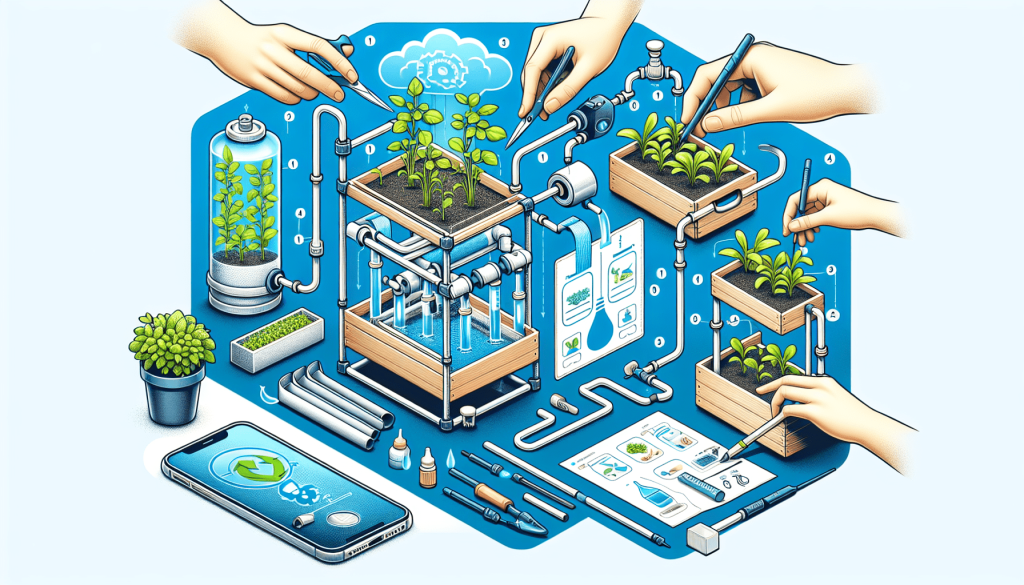
Watering and Feeding the Plants
Watering and nutrient feeding are essential aspects of hydroponic gardening. Here’s how to ensure your plants receive adequate hydration and nutrients:
Establishing a Watering Schedule
Establish a regular watering schedule to provide consistent moisture to your plants. The frequency of watering will vary depending on factors such as the plant species, growth stage, indoor humidity levels, and the type of hydroponic system. Monitor the moisture levels in the growing medium and adjust the watering schedule accordingly.
Proper Nutrient Feeding
Feed your plants with the appropriate nutrient solution regularly. Follow the recommended feeding schedule for each growth stage, adjusting as needed based on plant responses and nutrient levels in the system. Avoid overfeeding, as this can lead to nutrient burn or stunted growth.
Adjusting Nutrient Levels According to Plant Growth
As your plants grow, their nutrient requirements may change. Monitor the health and appearance of your plants and adjust the nutrient levels accordingly. High-demanding plants may require stronger nutrient solutions, while others may require a more diluted solution. Regularly check the TDS or EC levels to ensure the nutrient concentration is within the desired range.
By providing the right amount of water and nutrients, you’ll support healthy plant growth, development, and high yields in your hydroponic garden.
Harvesting and Enjoying the Fruits of Your Labor
The moment you’ve been waiting for has arrived: it’s time to harvest your hydroponically grown plants and enjoy the fruits of your labor. Here’s how to do it right:
Recognizing Harvest Time
Every plant has specific signs that indicate it is ready for harvest. Pay attention to factors such as size, color, texture, and taste. Research the specific indicators for each plant and harvest accordingly to ensure the best quality and flavor.
Proper Harvesting Technique
Use clean tools such as shears or scissors to harvest your plants. Cut the stems or leaves just below the point of attachment. Avoid damaging the neighboring plants or the growing medium in the process.
Storage and Culinary Tips
After harvesting, properly store your crops to maintain their freshness. Leafy greens can be stored in airtight containers or bags in the refrigerator, while herbs can be dried or frozen for later use. Tomatoes, cucumbers, and peppers are best stored at room temperature and should be consumed within a few days.
Experiment with different culinary creations using your freshly harvested produce. From vibrant salads to flavorful sauces, the possibilities are endless. Enjoy the satisfaction of knowing that you’ve grown these delicious, nutritious plants using your DIY hydroponic system.
In conclusion, creating your own DIY hydroponic gardening system is an exciting journey that allows you to grow a wide variety of plants in a controlled environment. By choosing a suitable location, selecting the right hydroponic system type, gathering the necessary materials and equipment, and following the steps to set up and maintain your system, you can enjoy a successful and rewarding hydroponic gardening experience. From choosing the right plants to starting seeds, monitoring and maintaining the system, providing adequate lighting, watering and feeding the plants, and finally harvesting the fruits of your labor, each step is essential to achieve optimal growth and yield. Embark on this adventure and discover the joys and benefits of hydroponic gardening firsthand. Happy growing!
